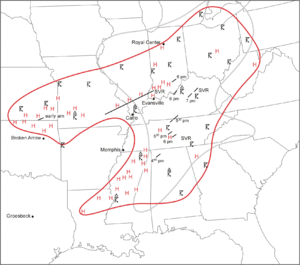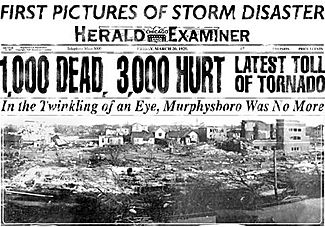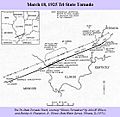Tri-State Tornado facts for kids

Weather conditions and atmospheric phenomena, including severe thunderstorm winds, hail, and tornadoes, observed on March 18, 1925
|
|
| Type | Tornado outbreak |
|---|---|
| Duration | March 18, 1925 |
| Tornadoes confirmed | ≥ 12 confirmed |
| Max rating1 | F5 tornado |
| Duration of tornado outbreak2 | 7 hours |
| Largest hail | 4+1⁄2 in (11 cm) at Lexington, Kentucky |
| Damage | Unknown; at least $1.4 billion (1997 USD) $2.55 billion (2025 USD) |
| Total fatalities | 751 deaths |
| Areas affected | Midwestern and southeastern United States |
| 1Most severe tornado damage; see Fujita scale 2Time from first tornado to last tornado | |
The Tri-State Tornado was the deadliest tornado in the history of the United States. It took place on Wednesday, March 18, 1925. It was during an outbreak of 12 confirmed tornadoes. It covered a large portion of the Midwest and Southern United States.
The death toll from one tornado alone was 695. In Illinois, there were 613 deaths. There were 11 deaths in Missouri. There were at least 71 deaths in Indiana.
The tornado wasn't officially rated by the National Oceanic and Atmospheric Administration. But it is recognized by most experts as an F5 tornado on the U.S. Fujita scale.
There were also tornadoes in Kentucky, Kansas, Alabama and Tennessee.
In 2018 U.S. dollars, damage from the tornadoes was $2.18 billion.
Aftermath and recovery
In the immediate aftermath, hospitals from St. Louis to Evansville were inundated with the injured and dying, as the storm injured more than 2,000 people, 105 of whom later died from their injuries. In Missouri, relief trains carried the most seriously injured north to St. Louis, while the remainder were sent to hospitals at Perryville and Cape Girardeau. At Gorham, where half the town's population was injured, the Missouri Pacific Railroad shuttled most of the injured north to East St. Louis, and the remainder south to Cairo.
The town hospital in Murphysboro, where several hundred were injured, was ill-equipped to deal with the casualties, prompting hundreds to be shipped out to other towns by train once the lines were cleared. The most seriously injured were sent by train to Barnes Hospital in St. Louis. For most of the injured, dying and destitute from Murphysboro, the college town of Carbondale, some seven miles to the southeast, provided a safe haven. At De Soto however, chaos ensued as the affected were scattered in three different directions; six miles south to Carbondale, five miles east to Hurst, or for many, fourteen miles north to Du Quoin. For the tornado victims at Parrish, relief came from Thompsonville three miles to the southeast, where a team of railroad workers with the Illinois Central Railroad led by a heroic physician from Iowa, pulled a train directly into the demolished village. The train was loaded beyond capacity with the dead, injured and dying before proceeding to the northwest to the hospital at Benton.
The storm claimed its final victim on January 3, 1926, when Gervais Burgess, a 46-year-old coal miner from West Frankfort, died from injuries sustained in the tornado.
In addition to the dead and injured, thousands were left without shelter or food. Fires erupted, growing to conflagrations in some places, exacerbating the damage.
In the end, a total of 695 were confirmed dead – 12 in Missouri, 95 in Indiana and 588 in Illinois. Three states, 14 counties, and more than 19 communities, four of which were effectively effaced (several of these and other rural areas never recovered), were in the path of the tornado, which had lasted a record duration of three and a half hours. Approximately 15,000 homes were destroyed by the Tri-State tornado. Total damage was estimated at $16.5 million in 1925 dollars; adjusted for increases in population/wealth and inflation, the toll is approximately $1.4 billion (1997 USD), surpassed only by two extremely destructive tornadoes, each of which was posthumously rated F4, both in the City of St. Louis, in 1896 and 1927.
Meteorological significance
While no photographs or film reels of the Tri-State tornado were taken or are known to exist, the tornado was frequently described by witnesses as an "amorphous rolling fog" or "boiling clouds on the ground", and fooled normally weather-wise farm owners (in addition to people in general) who did not sense the danger until the storm was upon them. The condensation funnel was also reportedly sometimes wrapped in copious dust and debris, which likely obscured it and made it less recognizable. The parent supercell apparently transitioned to a high-precipitation (HP) variety by the time it struck West Frankfort, meaning that the tornado was not readily visible, as it was often shrouded in heavy rain and hail. The very strong tornado – modern meteorologists estimate that its wind speeds topped 300 miles per hour (480 km/h) in some locations – at times exhibited an unusual appearance due partially to its size (at one point in Missouri, it was a full mile wide) and the probable low cloud base of its parent thunderstorm.
The tornado was often accompanied by extreme downburst winds throughout the entirety of its course; the accompanying downburst periodically increased the width of the damage path from the overall average of 0.75 mi (1.21 km), varying from 1 mi (1.6 km) to 3 mi (4.8 km) wide at times.
There has long been uncertainty as to whether the originally recognized reports of a 219-mile (352 km) path over 3.5 hours represent a single continuous tornado or multiple independently tracking tornadoes belonging to a tornado family. Because of the scarcity of verifiable meteorological data from the time of the event and the apparent absence of any record of a tornado having approached this path length and duration in the years since, doubts have been raised about the plausibility of the conclusion that a single tornado was responsible for them.
Modern meteorological theory regarding tornado and supercell morphology and dynamics suggests that a single tornado lasting for such a duration is highly improbable. Several other historical accounts of very long track (VLT) tornadoes have subsequently been determined to be the product of tornado families (notably the Charleston-Mattoon, Illinois tornado family of May 1917 and the Woodward, Oklahoma tornado family of April 1947). In more recent years, some VLT tornadoes and supercells have indeed occurred, with 12 tornadoes exceeding 100-mile (160 km) path lengths from 1980–2012, and 60 since 1950. Yet the high-end estimates of the Tri-State tornado path length are still far longer than the nearest verified VLT tornado. Only 4 tornadoes have confirmed paths longer than 124 miles (200 km) without being tornado families. Two of them occurred during the 2011 Super Outbreak, one an EF5, and another an EF4, another occurred during an outbreak in April 2010, rated EF4, and a fourth occurred in December 2021, also rated EF4. On the other hand, meteorological analysis reveals no record of any analogous mesoscale circumstances in recent history, meaning that the weather conditions which led to the Tri-State tornado were apparently unique. No single factor accounts for the exceptional path length and duration, though the fast forward motion of the tornado, which averaged 59 mph (95 km/h), may have translated to more distance covered.
In 2001, tornado expert Tom Grazulis wrote that the first 60 miles (97 km) of the track was probably the result of two or more tornadoes, and that a 157-mile (253 km) segment of the overall path length was seemingly continuous. Exhaustive research published in 2013 found no definitive resolution, but did locate additional tornado sightings and damage 15 mi (24 km) west of the previously known beginning of the tornado and 1 mi (1.6 km) east of the previously known ending, extending the total path length by 16 miles to 235 mi (378 km) long. The scientists concluded it is likely that at least some of the track, both at the beginning and ending, was indeed caused by separate tornadoes. They also located a 20 mi (32 km) path (apparently created within a period of about 20 minutes) from a large tornado which was likely spawned from the same supercell and was about 65 mi (105 km) east-northeast of the aforementioned path ending. This brings the known length of the Tri-State tornado family to around 320 mi (510 km) over nearly 5.5 hours.
The 2013 study concludes that it is likely that the 174 mi (280 km) segment from central Madison County, Missouri to Pike County, Indiana, was the result of one continuous tornado, and that the 151 mi (243 km) segment from central Bollinger County, Missouri to western Pike County, Indiana, was very likely the result of a single continuous tornado. Either of these two values still holds the record for the longest recorded tornado track. However, this 151-to-174-mile-long (243 to 280 km) segment of the path is considered most likely to be continuous solely because observations were sufficiently dense, whereas the 219-mile-long (352 km) portion from westernmost Reynolds County, Missouri, to westernmost Pike County, Indiana, contained several gaps in which eyewitnesses and reports of damage were lacking, owing primarily to sparse patterns of human settlement, but even this may well have been continuous because the alignment of reports showed a consistent heading, suggestive of a single tornado rather than a family.
Images for kids
See also
 In Spanish: Tornado triestatal de 1925 para niños
In Spanish: Tornado triestatal de 1925 para niños




